 W
WAglais io, the European peacock, more commonly known simply as the peacock butterfly, is a colourful butterfly, found in Europe and temperate Asia as far east as Japan. It was formerly classified as the only member of the genus Inachis. It should not be confused or classified with the "American peacocks" in the genus Anartia; these are not close relatives of the Eurasian species. The peacock butterfly is resident in much of its range, often wintering in buildings or trees. It therefore often appears quite early in spring. The peacock butterfly has figured in research in which the role of eyespots as an anti-predator mechanism has been investigated. The peacock is expanding its range and is not known to be threatened.
 W
WAnthocharis cardamines, the orange tip, is a butterfly in the family Pieridae, which contains 1100 species of butterfly. A. cardamines is mainly found throughout Europe and temperate Asia (Palearctic) The males feature wings with a signature orange pigmentation, which is the origin of A. cardamines' common name.
 W
WAporia crataegi, the black-veined white, is a large butterfly of the family Pieridae. A. crataegi is widespread and common. Its range extends from northwest Africa in the west to Transcaucasia and across the Palearctic to Siberia and Japan in the east. In the south, it is found in Turkey, Cyprus, Israel, Lebanon and Syria. It is not present in the British Isles and northern Scandinavia.
 W
WArgynnis ruslana is a species of butterfly in the family Nymphalidae. It is found in eastern China, Amurland, Korea, and Japan.
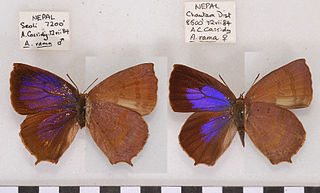 W
WArhopala rama, the dark Himalayan oakblue, is a small butterfly found in India, Indochina, China and Japan that belongs to the lycaenids or blues family.
 W
WHesperia florinda is a butterfly in the family Hesperiidae (Hesperiinae). It is found in the East Palearctic in Transbaikalia to Korea, Amur, Ussuri and Japan. The larva feeds on Carex. There is a single broods. The egg hibernates. Hesperia florinda was previously a subspecies of Hesperia comma.
 W
WThe large blue is a species of butterfly in the family Lycaenidae. The species was first defined in 1758 and first recorded in Britain in 1795. In 1979 the species became extinct in Britain but has been successfully reintroduced with new conservation methods. Currently large blue is classified as "near threatened" on the IUCN Red List of Threatened Species. Today P. arion can be found in Europe, the Caucasus, Armenia, western Siberia, Altai, north-western Kazakhstan and Sichuan.
 W
WLethe callipteris is a butterfly in the family Nymphalidae (Satyrinae). It is found in the East Palearctic where it is endemic to Japan, Sakhalin and the Kuriles.
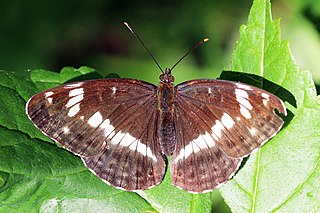 W
WLimenitis camilla, the (Eurasian) white admiral, is a butterfly of the family Nymphalidae. It is found in woodland throughout southern Britain and much of Europe and the Palearctic, extending as far east as Japan.
 W
WThis is a list of butterflies of Japan. About 327 species are known from Japan.
 W
WThe Japanese luehdorfia is a species of butterfly in the subfamily Parnassiinae of Papilionidae. It is found only in Japan. It was discovered by Yasushi Nawa in Japan's Gifu Prefecture in 1883. It is also known as the Gifu butterfly
 W
WMycalesis madjicosa is a satyrine butterfly endemic to Japan. The larva feeds on Imperata and Cortaderia selloana.
 W
WNeope goschkevitschii is a Nymphalidae butterfly found in East Asia. This species looks quite similar to Neope niphonica and these two species were treated as one for a long time.
 W
WNeope niphonica is a member of the Nymphalidae butterfly family found in East Asia.
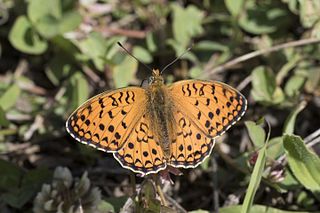 W
WThe Niobe fritillary is a species of butterfly in the family Nymphalidae.
 W
WPapilio macilentus, the long tail spangle, is a butterfly of the family Papilionidae. The species was first described by Oliver Erichson Janson in 1877.
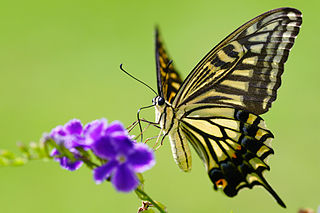 W
WPapilio xuthus, the Asian swallowtail, Chinese yellow swallowtail or Xuthus swallowtail, is a yellow-colored, medium to large sized swallowtail butterfly found in northeast Asia, northern Myanmar, southern China, Taiwan, the Korean Peninsula, Japan, Siberia and the Hawaiian Islands. It was also recorded in the state of Arunachal Pradesh, India, in 2014.
 W
WPelopidas jansonis is a butterfly in the family Hesperiidae (Hesperiinae). It is endemic to Japan. The larva feeds on Miseanthus (Graminea). There are two broods. The larva of the second brood hibernates.
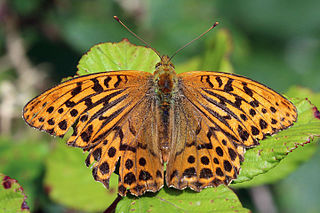 W
WThe silver-washed fritillary is a common and variable butterfly found over much of the Palearctic realm – Algeria, Europe, temperate Asia, and Japan.
 W
WThe small tortoiseshell is a colourful Eurasian butterfly in the family Nymphalidae. Adults feed on nectar and may hibernate over winter; in warmer climates they may have two broods in a season. While the dorsal surface of the wings is vividly marked, the ventral surface is drab, providing camouflage. Eggs are laid on the common nettle, on which the larvae feed.
 W
WThe speckled wood is a butterfly found in and on the borders of woodland areas throughout much of the Palearctic realm. The species is subdivided into multiple subspecies, including Pararge aegeria aegeria, Pararge aegeria tircis, Pararge aegeria oblita, and Pararge aegeria insula. The color of this butterfly varies between subspecies. The existence of these subspecies is due to variation in morphology down a gradient corresponding to a geographic cline. The background of the wings ranges from brown to orange, and the spots are either pale yellow, white, cream, or a tawny orange. The speckled wood feeds on a variety of grass species. The males of this species exhibit two types of mate locating behaviors: territorial defense and patrolling. The proportion of males exhibiting these two strategies changes based on ecological conditions. The monandrous female must choose which type of male can help her reproduce successfully. Her decision is heavily influenced by environmental conditions.
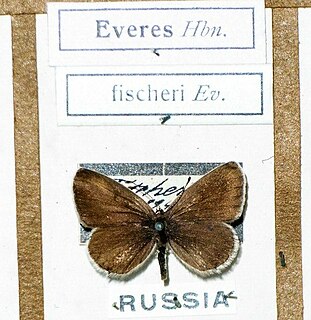 W
WTongeia fischeri, or Fischer's blue, is a butterfly of the family Lycaenidae. It was described by Eduard Friedrich Eversmann in 1843. It is found in south-eastern Europe, the southern Ural, northern and eastern Kazakhstan, south-western and southern Siberia, the Russian Far East, Mongolia, China, Korea and Japan.